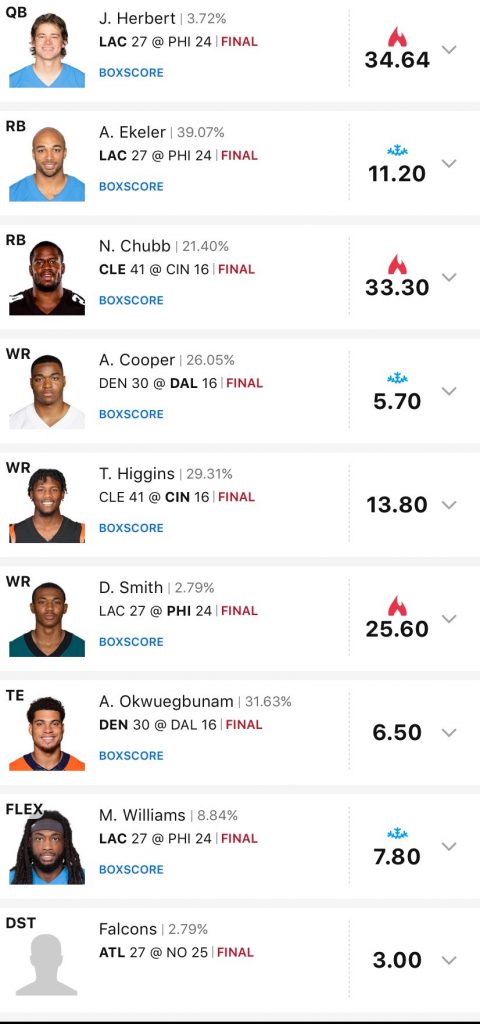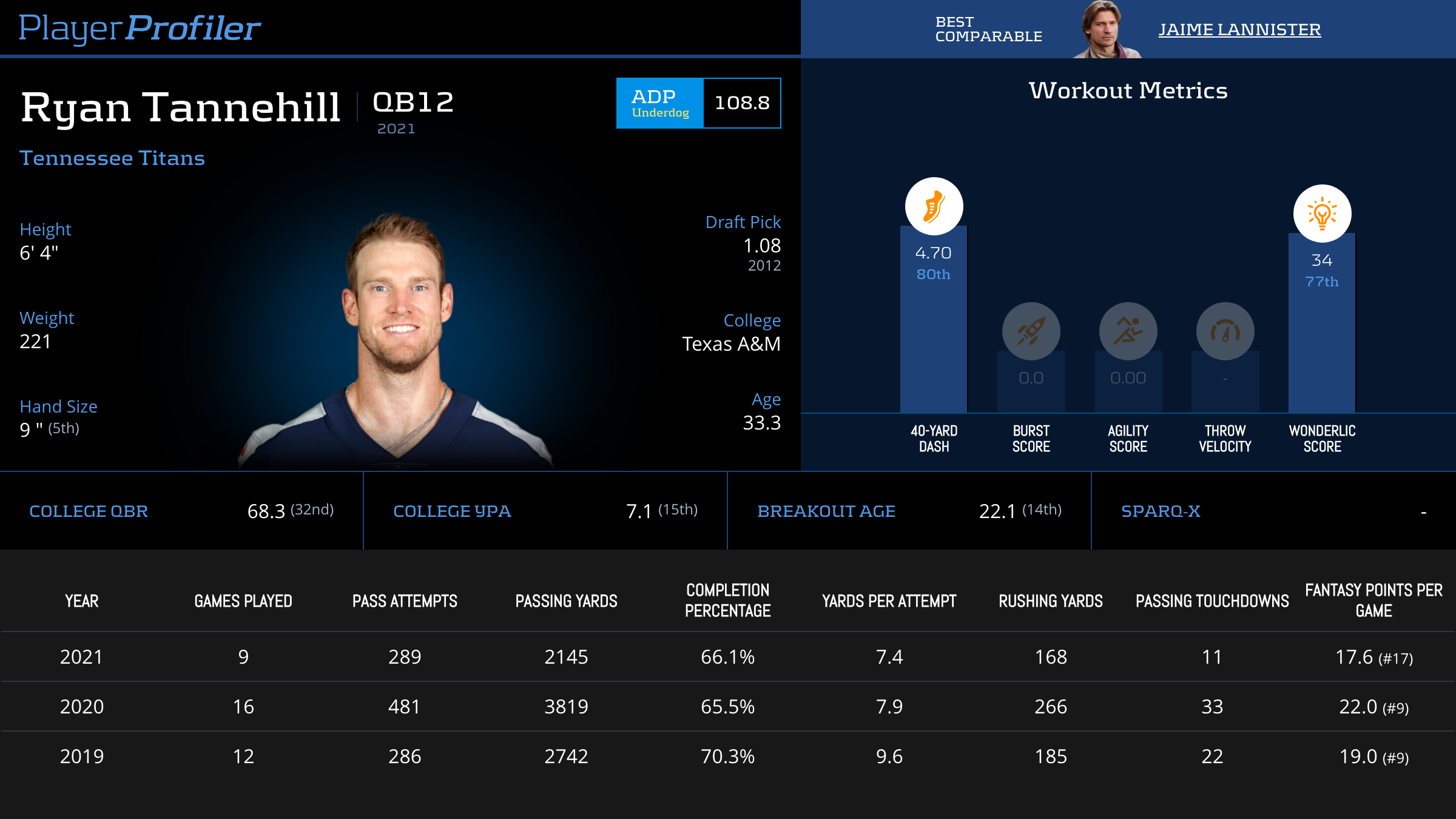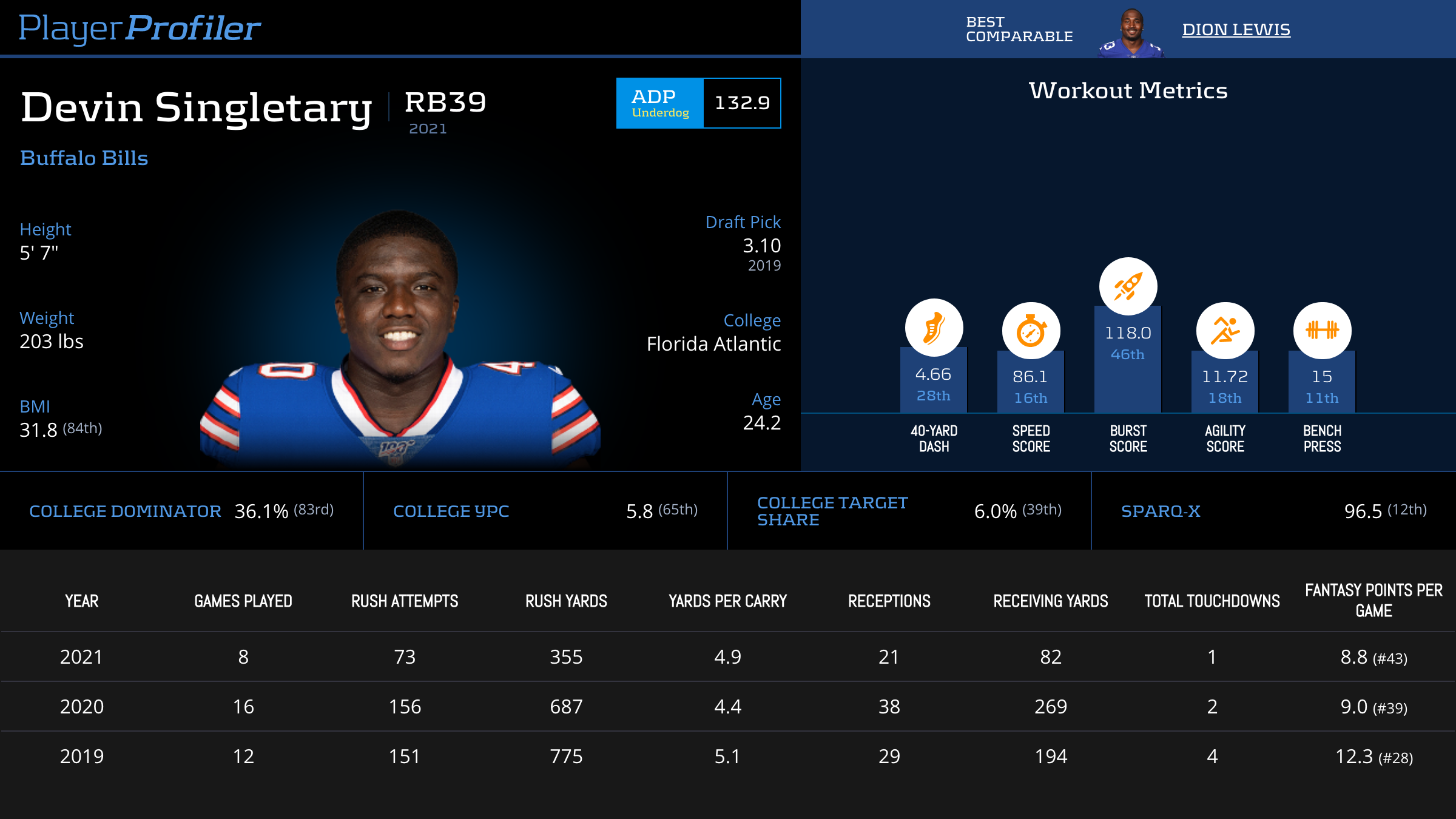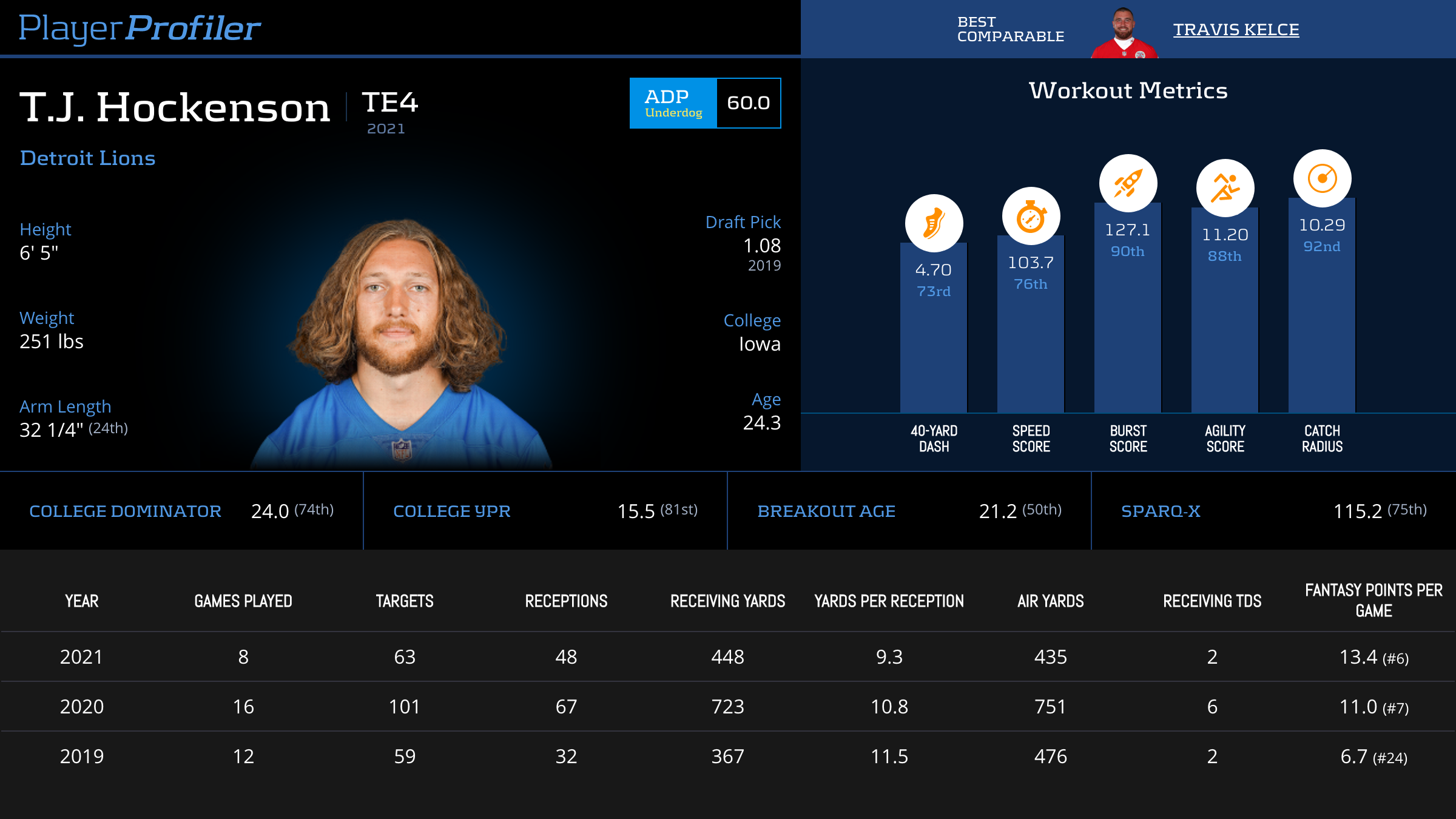Does anyone know the reason why popular plays are called chalk?
In horse racing, odds used to be displayed on a chalk board at the track. When a horse would be bet repeatedly, the track worker had to manually adjust the odds on the chalkboard. Sometimes a horse would be bet so often, the worker would have to keep updating the odds shorter and shorter. Eventually, the chalk would be smeared so heavily from being erased and re-written, nobody could even read the odds. Thus, heavy favourites were henceforth referred to as ‘chalk.’
Many people treat DFS like horse racing, If there is a 5-4 favourite (VERY heavy odds), and the favourite wins, you either bet the favourite or you lost. However my friends, Lamar Jackson is not a horse.
Last week I played zero Jackson in 20 tournament lineups. He projected well, and had a strong game environment, but the ownership on Jackson and Marquise Brown was far too aggressive for me to swallow on a slate with few other leverage opportunities.
You may now be expecting me to ‘chalk’ this up as a lost week due to play-style. However, it was actually a profitable week! My most-played quarterback was Justin Herbert. Herbert and Keenan Allen combined to score 60.04 DraftKings points. This marginally edged out Jackson and Brown who combined for 59.24. When you add in the optimal ‘bring back,’ Devonta Smith + Herbert + Allen combined for 85.64 DK points at a salary of $18,900. Jackson + Brown + Justin Jefferson combined for 76.24 DK points on $20,800.
I’m not opening my article with this to celebrate my omnipotence for playing Chargers stacks. In fact, my highest stakes lineup played Mike Williams over Keenan Allen, resulting in a 17th place finish instead of a top five. Instead, I want you to remember that ‘fading’ chalk pieces is never a binary outcome. You are generating the most leverage if the chalk piece fails, but you always have the out to match or beat the chalk with your own plays.
This week has a number of obvious chalk plays, and it will be imperative to decide which chalk we are eating, and which we are avoiding or leveraging. So without further ado, let’s get into it!
A weekly note: This is not your typical DFS column. We rarely discuss matchups, nor do we debate the ‘best’ plays. This is a column about using game theory to find edges on the field not captured by projections. If this is your first time reading, I encourage you to check out my evergreen, introductory column which covers concepts I re-visit in the weekly editions.
The Pareto Principals: Guiding Principles For Limited Entry DFS
Week 9 Review
I’ve already my Week 9 thoughts above, so just one lineup review for today. To be honest, I’m conflicted on whether this was a strong build or not and I want to talk it through.
Week 9 Lineup Review
This was not my highest-scoring entry, but was placed in my highest dollar contest; a very-small field 215 person contest. Due to the character of Week 9, 141.54 was somehow good enough for 17th place. This lineup was three decisions away from drawing live for first: playing the wrong Chargers receiver, playing a dud defense, and playing Amari Cooper.
Two of those decisions offer nothing to discuss from a process point of view. I played seven Herbert lineups out of 20 total entries, and split them evenly between Mike Williams and Keenan Allen. They projected similarly both in production and ownership, and both were equally viable plays going in to the slate. Defense bears an immaterial correlation to price or ownership. Rostering a defense at $2,500, with 3-percent ownership playing against Trevor Siemian is a bet I will make every single day.
The interesting conversation is Cooper. I will lay out why I built the rest of my lineup this way, and leave it for you to judge if I erred here.
Size Matters: Using Chalk to Block in Small Fields
Justin Herbert came in just 3.72-percent owned, meaning he was only played eight times in this contest. Add in Devonta Smith at 2.79-percent ownership (played just five times) and I had virtually zero competitors benefitting alongside me if my stack hit perfectly. Typically in DFS I think about my competitors in two levels. 1) How do I reach my precondition to win? 2) How do I beat my opponents who have the same precondition as myself?
In this lineup I decided to get all leverage on the first precondition. Lamar Jackson was going 30-percent owned in small field contests, and Austin Ekeler was the highest rostered-running back on the slate. Given Ekeler’s pass-catching role he correlates positively with Justin Herbert; a stack I employed with success in Week 5. I looked at Ekeler, and made a bet that I could play the same structure as the Jackson teams, but use a hardly-owned quarterback who correlates with my RB1 to separate from the field. After that, I filled the rest of my lineup with the highest projected plays to play keep away if my stack hit.
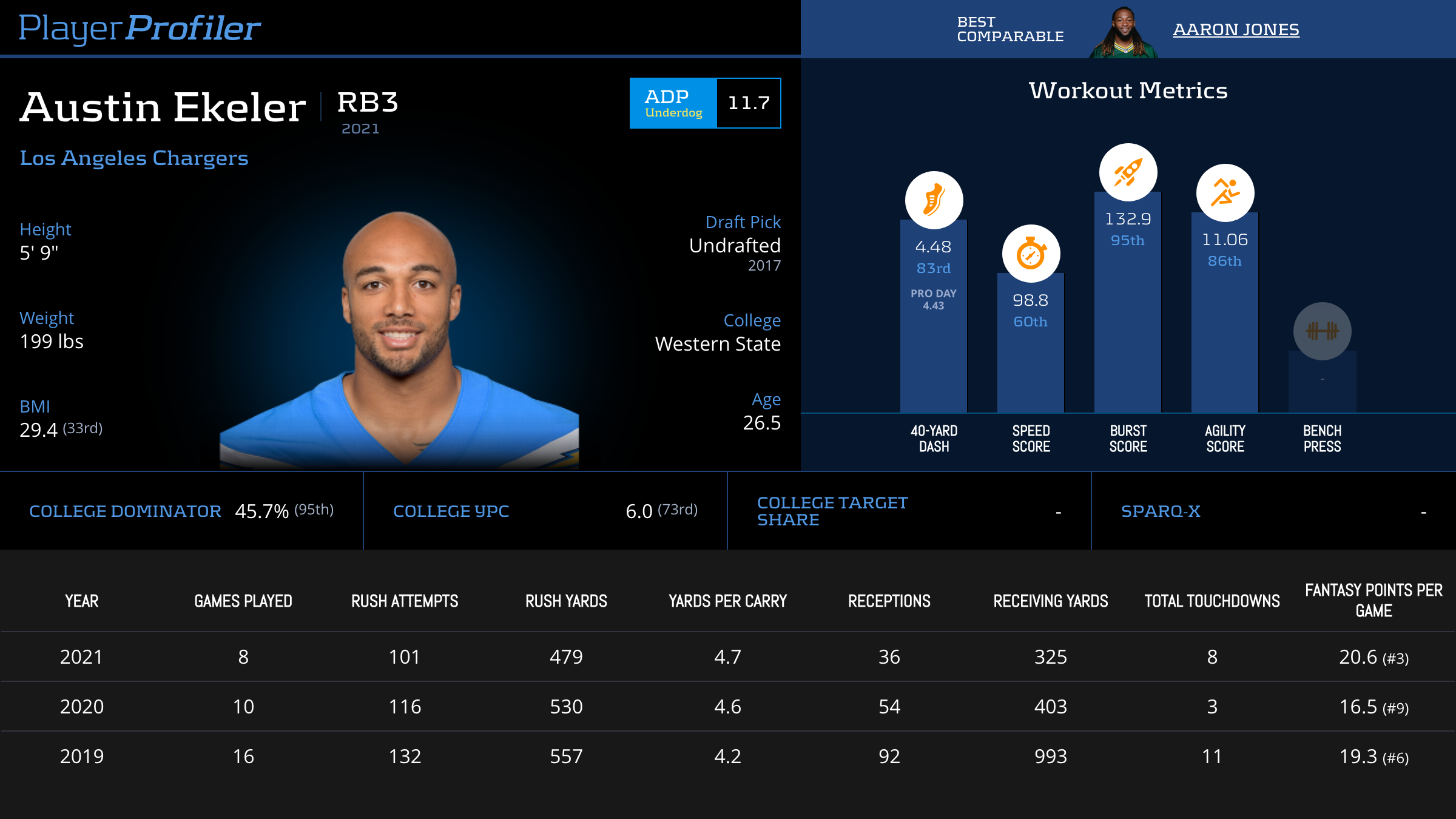
Pass-catching backs often go under-stacked with their QBs despite a positive correlation & maximum touchdown equity
If this were a 10,000 person tournament, even if ownership were the same, there would have been 372 other Herbert teams; likely a fair amount of which with Williams and Smith. If I’m drawing live from my stack, I’m now in a small field tournament with these opponents.
While I can accept some popularity, I would never play four correlated pieces with 20-percent ownership or higher. It places too high a bar on me to be perfect with each choice since a large number of people will continue to reap the same benefits I am on each player’s performance.
However, in a 215 person field the equation changes dramatically. If my stack hit its ceiling, I did not need to worry about beating hundreds of other Hebert teams. All I’d need to beat are teams who are chasing me from behind. Thus, it is to my advantage to play (A) players who project for the most total points regardless of ownership, and (B) play players who are the MOST owned, in order to block my opponents from catching me through duplication.
I do think there’s an argument I still should have pivoted off one of the two chalk-correlations. But had I played Allen over Williams I finish 4th-place, and even with the benefit of hindsight I feel strongly about the Cooper play. The only option at his price who projected equally well was Marquise Brown, who was more owned, and correlated to the chalk quarterback I was trying to defeat. Alas, Cooper simply failed me.
Week 10 Preview
This week’s slate has an opposite character to the last. After a week with flat ownership and projection, we now have several clear-cut elite plays who project to be highly owned. Devin Singletary and D’Ernest Johnson both project as high-end free square running backs should Zack Moss and Nick Chubb be ruled out. At the high end, Jonathan Taylor and Najee Harris are blessed with elite matchups against the Lions and Jaguars. From a stacking perspective, Cowboys-Falcons and Chargers-Vikings are a field-g0al ahead of the field in game total, and the Buccaneers have a consolidated pass-catching group against one of the league’s worst secondaries.
It will be imperative to decide which of these spots to attack, and how to set up your lineup around them.
Strategic Overview
Pending injury news, the common structure this week should include one elite running back, paired with one of the free squares, and a game stack around it in the wide receiver slots. This generally presents an either/or question for you to consider in each lineup. Would you rather pair one of the top-owned game-stacks with a unique running back construction? Or would you rather stack an under the radar game and give yourself the chance to play any running backs you wish?
Good Chalk / Bad Chalk
With the caveat that any sufficiently-projected player can be positive-expected value in the context of the right lineup, these are my general guidelines for evaluating high-owned situations in tournament DFS.
1. What is the size and structure of your contest?
As discussed above, the size of your contest is hugely important. In general, you can play more highly-owned lineups in smaller field contests, but I also have a preference for fading-correlated chalk in smaller fields as opposed to highly-projected one-offs.
In smaller fields (especially at mid and high stakes), ownership tends to be more consolidated than in large fields. People aren’t max-entering 150 lineups, they know they can play higher-owned lineups, and these fields are usually filled with sharper players who won’t submit entries with terrible projections. I always say in this column that my goal is to submit lineups that require the fewest number of correct assumptions to win. It is not uncommon to see situations such as last week where a high-ceiling stack such as the Chargers is less than five-percent owned in a small field. Because you are correlating one under-owned decision, you can play far more chalk-pieces around it. I’m playing three-four under-owned players, but it’s all correlated to one singular outcome.
This is always my favourite way to play small-fields. Here is one of my favourites this week.
Remember The Titans
I try not to fade Vegas, but this week I am going out on that limb. New Orleans is treated by the market as an elite defense, but are we sure? They have given up a top-5 fantasy performance to each of Matt Ryan and Tom Brady the past two weeks, after a season of playing against truly horrible passers.
From Weeks 2-7, here is the list of opposing quarterbacks the Saints have played against:
Sam Darnold, Mac Jones, Daniel Jones, Taylor Heinicke, and Geno Smith.
Ryan Tannehill will instantly be one of their toughest tests of the season, in an offense that needs a new identity after losing Derrick Henry. Julio Jones sustained an injury in practice this week and may miss, leaving A.J. Brown as a locked-in stacking partner.
Brown has seen a 32-percent Target Share in each of his last four games, giving him WR1 overall upside in any week. If Alvin Kamara misses, Mark Ingram will certainly be popular, but the presence of D’Ernest Johnson and Devin Singletary may keep his ownership lower than you’d otherwise expect. Playing this game as a stack helps mitigate the ownership on Ingram through correlation, and allows you to more salary to work with elsewhere vis a vis the lineups paying up at quarterback.
2. Are you playing the ceiling or the floor?
Often times chalk plays in tournaments resemble the most popular plays in cash-games. While it’s possible for a player to be an elite option in both formats, the percentile range you are projecting changes depending on the win condition of your contest.
Devin Singletary has crested a 70-percent Snap Share 11 times in his career. He has scored 20 fantasy points on zero of those occasions, despite scoring above 10 seven times.
From a statistical point of view, Devin Singletary would project very well if Zack Moss is ruled out at his median. Against the New York Jets, an outstanding matchup for running backs – especially in the passing game – he will project to perform well for his salary. However, most of that projection is based on his floor, not his ceiling. The distribution of his outcomes is quite narrow. He does not have a higher chance to perform at the level required for a tournament winning line-up compared to other similarly priced options, and would be a fade for me at high-ownership in large fields.
Mike Evans presents a very different proposition. His floor certainly raises if Chris Godwin joins Antonio Brown and Rob Gronkowski on the inactive list, but above all else I fear being buried by his ceiling. Evans always has a 40-point ceiling within his range of outcomes. This presents a raw-point output that would be significantly harder to counter than a strong point-per-dollar performance by a free-square running back.
3. Chalk as a Function of Construction
This is likely the point most-often left out when debating the validity of a chalk play. Sometimes even if the ceiling of an individual play is limited, the ability to access a floor at a low salary can open up ceiling for the rest of your roster you could not access otherwise.
This is I am willing to play Tyler Johnson this week should Chris Godwin sit. There just is no comparable projection at $3,300 to Johnson if he is serving as the number two receiver for Tom Brady this week. The issue is, if everyone diagnoses the same places to spend down it creates construction consolidation. Everyone spends down at the same spots to open up salary to spend up at the same spots. Week 1 was the greatest example of this studs and duds build structure.
If I am following this method of construction on the spend-down side, I need to spend up at different spots. For instance, last week I spent up at quarterback but did so with a stack nobody was playing. This week, that strategy appears to me more arduous to pull off. Nonetheless, I have identified one intriguing construction for this strategy.
T.J. Hockenson is finally off the injury report, and facing a Pittsburgh defense which was carved up by the unimposing Bears tight end combination. With all the highest-scoring tight ends off the slate, most will be punting the position to spend up at wide receiver and running back. It is hard to imagine Hockenson’s ownership cresting 10-percent when Kyle Pitts – the only other premium tight end on the slate – is playing in the highest-total game on the slate. Hockenson gives you a different construction, but maintains the upside to gap the field at tight end.
4. Can you Mitigate Chalk via Correlation?
The last element I’ll discuss for today is the ability to mitigate chalk via correlation. In last week’s column, I discussed the incentive to only play Michael Pittman in game stacks on the Week 8 slate. Playing chalk pieces together ensures you receive the maximum benefit from its success. Using Hockenson, as mentioned above, can help mitigate the ownership on a Diontae Johnson or Najee Harris entry.
I will present a slightly different angle for this week’s slate. Minnesota-Los Angeles projects as one of the highest-owned games on the slate, but with Harris and Jonathan Taylor likely to pace the field in ownership, it is probable we see Dalvin Cook and Austin Ekeler come in at a lower figure than they should based on their game environment. Due to Ekeler’s passing game role, both running backs are playable together in Chargers stacks, giving you a unique build of a high-owned game, and a unique construction by deferring the free square at RB2.
The Final Word
This was a fun column for me to write this week with a lot of strategic intersections on the week 10 slate. I look forward to piecing this together into a set of lineups tomorrow, and discussing the results with you again next week.
Good luck and enjoy the games!

